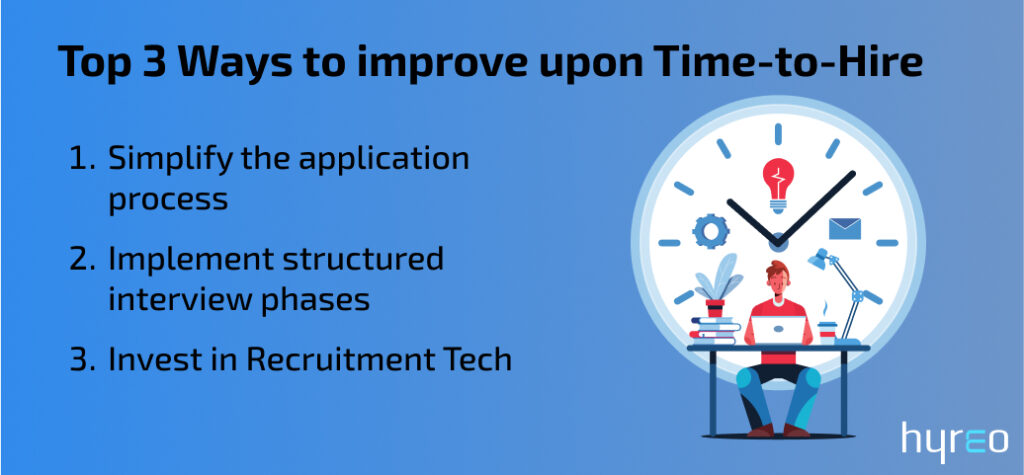Hiring talent is a race against time, with the odds stacked against the recruiters in the current candidate-driven job market. With talent being spoiled for choice, a lengthy hiring process could have an adverse impact on the company’s ability to attract highly skilled candidates at a higher hiring cost.
According to a survey by Robert Half, 57% of job-seekers lose interest in a job if the hiring process is lengthy.
In light of that, tracking and improvising based on SMART metrics give the companies the much-needed business edge and performance.

What is Time-to-Hire?
Time-to-hire is the time taken from the point a candidate applies for a position up until they accept the formal offer from a company. Measured in days, it is indicative of the factors that lead to a delay in onboarding a candidate due to inefficiencies in the overall hiring process.
While the specialized and senior roles would take longer based on the level of scrutiny and rounds of evaluation, time-to-hire is an indication of the efficiency of the recruitment process and hiring strategy and so is a key metric to track and take corrective action on.
Reducing time-to-hire has a direct bearing on the candidate experience and the brand image of the company.

5 Benefits of measuring time-to-hire
Analysis of key metrics such as time-to-hire and time-to-fill against the recruitment life cycle provides clarity on the hiring aspects that are ineffective, time-consuming and expensive. This in turn helps reallocate the right effort and budget to improve the recruitment process efficiency.
#1 Improve efficacy of Sourcing & build a strong Talent Pipeline
A higher time-to-hire could indicate a challenge with the candidate sources with them either not providing enough profiles or high quality talent or worse, recruiters not being able to understand the companies hiring needs (business or cultural) effectively. It could be due to the improper understanding of the business hiring needs, causing unappealing Job Posts & sketchy JDs, attracting lesser qualified talent for the positions.
A critical review of the effort and cost spent on sourcing and interviewing candidates highlights the strength, quality and turnaround time of each of the sources, helping build a strong talent acquisition plan and thereby a robust Recruitment Funnel with diverse, high-quality candidate pools & sources of talent.
#2 Rationalize recruitment process
Mostly, a higher time-to-hire presents an opportunity to sort out the bottle-necks in the recruitment process, helping save cost and effort and thereby improve the candidate experience. A higher turnaround time, more interviews & longer wait-times, more candidate drop-outs during the interview to offer period etc. could be the symptoms observed.
In order to build efficiency in the recruitment process, breaking the recruitment process into different hiring segments helps understand the effectiveness, effort & cost of each of them, helping rationalize the process.
#3 Leadership buy-in for investment in Recruitment Tools & Software
While optimizing the recruitment process, it is important to build repeatability & consistency at scale into the process. Here, the many diverse recruitment tools & software available in the market would be of immense help, helping automate the recurring and transactional activities, improving the hiring experience of the recruiters and the candidates alike.
Highlighting the recruitment cost and effort loss due to the inefficiencies can help convince and get leadership approval for appropriate tech investment in improving the brand appeal and image of the company.
#4 Onboarding and training
When a new hire joins the company, one of the first things that they receive is an information packet which contains the studying and training plan. The result? An induction program where the new hire is often bored and doesn’t take in too much information.
AI can be a powerful tool to enhance this aspect of the hiring process, which is often overlooked. Interactive programs and gamification will lead to increased participation from the new hires. As a direct result of their increased participation, the new hire will also retain more information. This finally results in happier employees and increased productivity from those very same employees.
#5 Improve effectiveness of key stakeholders
With the number of stakeholders involved, from the hiring agencies to the company’s talent acquisition team, hiring managers and leaders, it is often difficult but important to review and monitor very closely. Errors & misses in key milestones, longer interview wait-times, quality of hires & more candidate drop-outs during the interview to offer period etc. could be the symptoms observed.
Rationalizing the entire recruitment process with clear objectives, expectations and ownership of key activities with a view to make the candidate experience a delightful & engaging one, will help improve the brand image and onboard exemplary talent quickly.
Time-to-Hire Vs Time-to-Fill
Time-to-hire and Time-to-fill are key metrics used by organizations to determine and drive up business value while lowering the inordinately high recruitment costs through a dynamic data-driven Talent Acquisition Strategy.
While Time-to-fill measures the number of days from the point of approval of a job requisition up until a candidate accepts the offer, Time-to-hire gives the number of days from when a candidate applies for a job until they accept the offer. In measuring these KPIs, the key difference is the start date of measurement, i.e. date of job requisition approval in the case of Time-to-fill and date of application by the candidate for Time-to-hire.
While both of them are strong indicators of the effectiveness of the overall Talent Acquisition Strategy, Time-to-hire measures the recruitment process efficiency and Time-to-fill shows the efficiency of the organizational recruitment process.
Also read: What is Time to Fill and How to Reduce It
What is an average Time-to-Hire?
Heavily driven by and dependent on the factors external to the recruitment process such as candidate quality, skills being sought, seniority & criticality of the roles, it becomes harder to determine on an ideal Time-to-hire.
That being said, based on the available data, per SHRM, an average Time-to-hire of 24 days between screening suitable candidates and offer acceptance is accepted and worked with.
7 Ways to improve upon Time-to-Hire
Highly talented candidates are hired by companies within 10 days! Knowing that, it becomes critical to reduce Time-to-hire to be as short as possible to stand any chance in the highly competitive job market.
The more efficient the recruitment process, the higher the chances of hiring stellar talent at lower cost with higher business outcomes.
#1 Up your Social Brand
In order to attract high quality talent, it is critical to have appealing and crisp job posts. Towards that, refine job descriptions and update the careers page to include employee value propositions clearly, helping top talent choose brands well and fast.
#2 Simplify the application process
One of the key deterrents in attracting and keeping top candidates throughout the hiring process, it is important to rationalize the application process to have fewer steps and an easy and intuitive interface. This helps reduce non-value adding steps and hence the time to select and onboard talent.
#3 Segment & review the hiring process
Drive efficiency into the different recruitment stages by breaking them down and reviewing each of the activities critically. This will help uncover non-productive steps or processes that are expensive and time consuming, helping take appropriate corrective action.
#4 Implement structured interview phases
Optimizing the interview process, by structuring it better, helps improve the candidate engagement and chances of quick conversions. It also helps drive down overall organizational cost by optimal utilization of the various stakeholders involved in the recruitment life cycle.
#5 Use skills assessments
Pre-interview assessments, behavioral and technical, help find top quality candidates and help save precious time spent on interfacing and rejecting unqualified candidates. It helps recruiters spend more time on high quality candidates and lesser time on transactional activities.
#6 Invest in Recruitment Tech
Investing in the right recruitment tools & software like Hyreo help streamline the overall recruitment process, through automation of recurring and transactional activities as well as collaboration, helping save recruiter time and effort and improving their effectiveness and create employer brand. These are especially beneficial for high-volume hiring, with significant cost and effort savings.
#7 Set up Talent Marketplace and Employee Referral
Training and leveraging internal talent serves as a great way to not only source great culturally aligned, proven talent into higher outcome roles but it also helps engage and retain them better. Employee referrals is another key component of a talent pipeline, enabling you to hire top talent faster.
Wrapping Up
With today’s talent looking for exceptional career and life experiences, it is important for companies to provide the best candidate experience on point, right from the start. While Time-to-hire is a key metric that has a direct impact on the candidate experience and their willingness to join, it is crucial to have a data-driven dynamic Talent Acquisition, empowered by SMART KPIs.
With the short-term intent of reducing the Time-to-hire is to enhance candidate experience & accelerate hiring of talent, long-term benefits of using metrics to drive the talent acquisition is direct bottom line impact, enhanced brand image and business growth.
FAQs on Time to Hire
What is time to hire in recruitment?
Time to hire in recruitment refers to the time taken from the time a candidate applies up until they accept the final offer at a company (some companies use the end date as the date of onboarding of the talent). Measured in days, it indicates the efficiency of the hiring processes and has a direct impact on the candidate experience.
How long do companies usually take to hire?
The time taken by companies to hire candidates depends on a lot of factors such as skills, location, seniority & criticality of the roles and so it is hard to determine an ideal Time-to-hire. That said, based on the available data, per SHRM, an average Time-to-hire is 24 days.
What is a good interview to hire ratio?
While the interview to hire ratio depends on a variety of factors such as the skills, expertise, level and criticality of the role being hired for, a good interview to hire ratio would be 3:1. This means that for every 3 candidates interviewed for an open position, one is selected and extended a formal offer.
How do you calculate days to hire?
The days to hire, better known as Time-to-hire is a key recruitment metric that helps understand the hiring process efficiency. It is calculated based on the difference between start and end dates of a candidate application, with the start date being the date of a candidate applying for the post and the end date being the date they accept the formal offer for the position. Here, some companies use the end date as the date of onboarding of the talent.
Why is it important to reduce time to hire?
An important metric to track the hiring efficiency of a company, the Time-t-hire directly impacts candidate experience and their willingness to join. It is important to reduce Time-to-hire to attract top talent, reduce hiring costs, and drive higher business outcomes with an enhanced brand image.




